The recent Economic Survey 2023-24 addresses what developed nations often refuse to acknowledge and what India has always advocated — accepted climate-suitable pathways need to account for a variety of approaches with optimality at their core.
Crucial Insights on the Climate Aspect of the Economic Survey
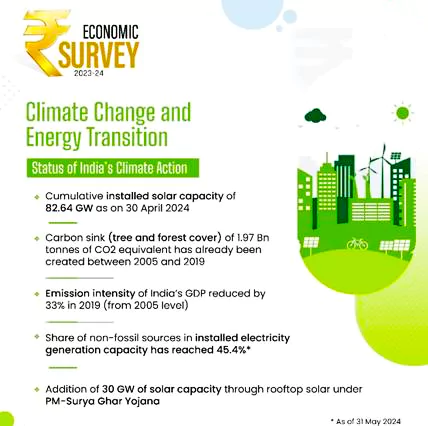
The Survey mentioned that the hallmark of India’s growth strategy is to manage the impact of climate change and at the same time give desired focus to developmental priorities.
- A Responsible Nation: A recent report by the International Finance Corporation highlighted that India is the only G20 nation in line with the 2-degree Celsius global warming cap, and is in mission-mode to fight climate change.
- Rising Energy Demands: In view of India’s growing developmental priorities, the country’s energy needs are expected to grow 2 to 2.5 times by 2047.
- Contribution by GDP: India’s total adaptation-relevant expenditure has increased from 3.7% of GDP in 2015-16 to 5.60% of the GDP in 2021-2022, indicating integration of climate resilience and adaptation into development plans.
- India’s GDP between 2005 and 2019 has grown with a Compound Annual Growth Rate (CAGR) of about 7%, whereas the emissions grew at a CAGR of about 4% i.e., the rate of emissions growth is lower than the rate of growth of our GDP.
- This shows that India has successfully decoupled its economic growth from greenhouse gas emissions, reducing the emission intensity of its GDP.
Enroll now for UPSC Online Course
Significant Progress Made by India on Climate Action
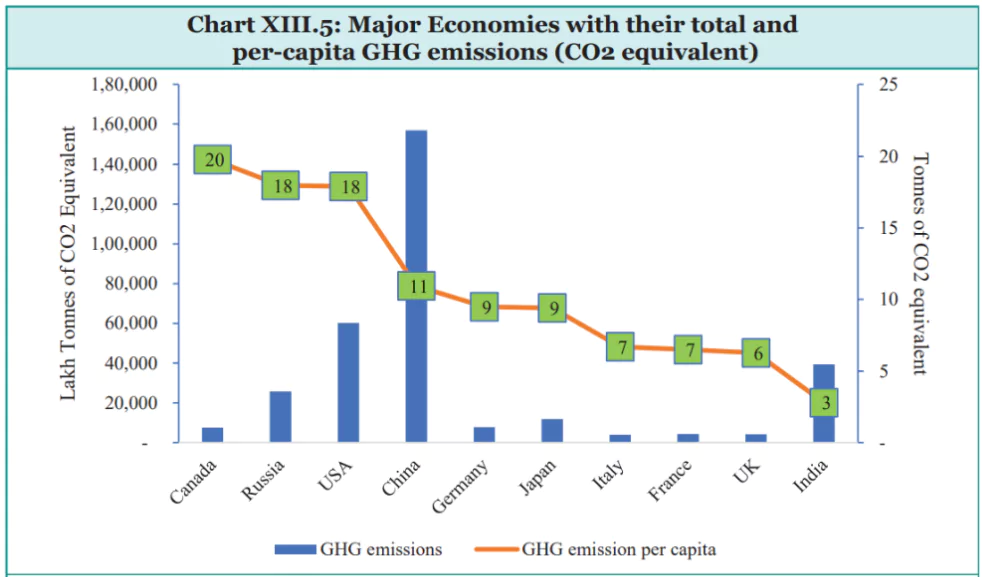
In recent years, the urgency of addressing climate change has become increasingly evident, propelling nations worldwide to commit to ambitious clean energy targets. Among these nations, India has emerged as a pioneer in sustainable development and climate action.
- Reduction of Emission: Despite being one of the fastest-growing economies in the World, India’s annual per capita carbon emission is only about one-third of the global average.
- India has successfully reduced the emission intensity vis-à-vis its GDP by 33% between 2005 and 2019, thus achieving the initial Nationally Determined Contributions (NDC) target for 2030, 11 years ahead of scheduled time.
- Progress on Renewable Energy: India has achieved 40% of electric installed capacity through non-fossil fuel sources, nine years ahead of the target for 2030.
- Between 2017 and 2023, India has added around 100 GW of installed electric capacity, of which around 80% is attributed to non-fossil fuel based resources.
- As of 31 May 2024, the share of non-fossil sources in the installed electricity generation capacity has reached 45.4% up from 32% in April 2014.
- Rise in Tree and Forest Cover: India is also on track to make an additional carbon sink of 2.5 to 3.0 billion tonnes through tree and forest cover by 2030, with a carbon sink of 1.97 billion tonnes of CO2 equivalent having already been created from 2005 to 2019.
- Well Performer: India has ranked 7th in a report, Climate Change Performance Index (CCPI) 2024, published on the sidelines of the COP28 in Dubai.
- India is effectively in fourth position, as the first three ranks in the ‘very high’ performance category remained vacant.
About India’s Climate Policy
India’s commitment to climate action traces back to the inception of the National Committee for Environmental Planning and Coordination (NCEPC) in February 1972.
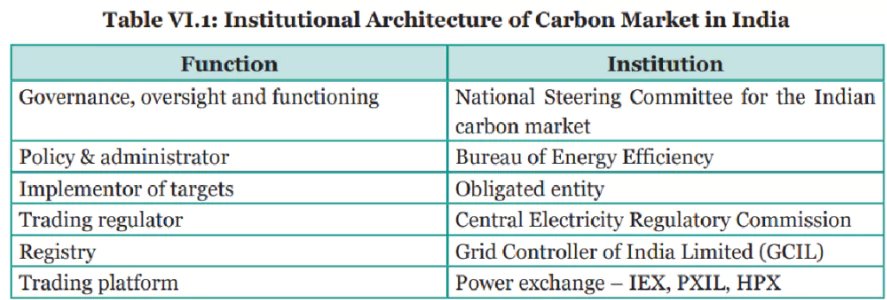
- In 1972, then-Prime Minister Indira Gandhi addressed the Stockholm conference, outlining India’s climate stance as well as that of the global south.
- In the 1990s, new policies emerged worldwide in many areas, including the environment.
- The 1992 Rio Summit saw the emergence of the United Nations Framework Convention on Climate Change (UNFCCC) and the Convention on Biological Diversity and Forest Principles.
- India has developed its policy response through missions and programmes to reduce its climate vulnerability. On 30th June 2008, the National Action Plan on Climate Change (NAPCC) was released.
- India’s climate policy has always been clear, consistent, and coordinated.
- India’s efforts to address climate change are immediate, ambitious, and planned, covering every sector of its economy.
- Statute: After the Rio Summit, the climate change and biodiversity divisions in India’s then Ministry of Environment and Forests came to life slowly and steadily.
- Vision: India’s climate policy is shaped by its vision of inclusive growth for all-round economic and social development, the eradication of poverty, a declining carbon budget, firm adherence to the foundational principles of the UNFCCC, and climate-friendly lifestyles.
Various Initiatives taken by India to Combat Climate Change
Recognising the importance of climate and supporting energy security, following measures have been taken by India:
- On Energy Efficiency: Implementing Energy Conservation Building Code (ECBC) for buildings, Standards and Labelling (S&L) and Star-rated program for appliances, Lifestyle for Environment (LiFE) initiative for encouraging the adoption of sustainable lifestyles, Perform, Achieve, and Trade (PAT) scheme for industrial sector, and Charging Infrastructure for Electric Vehicles for transport sector, among others.
- All above mentioned initiatives translate to a total annual cost savings of approximately ₹1,94,320 Crore and an annual CO2 emissions reduction of around 306 million tonnes.
- Finance for Sustainable Development: India has taken many measures to improve the business environment and catalyse greater quantum of resources.
- Sovereign Green Bonds: The Government undertook the issue of sovereign green bonds amounting to ₹16,000 Crore in January-February 2023 to raise proceeds for public sector projects that would contribute to the efforts to reduce the intensity of the economy’s emissions.
- It was further followed by ₹20,000 Crore raised through sovereign green bonds in October-December 2023.
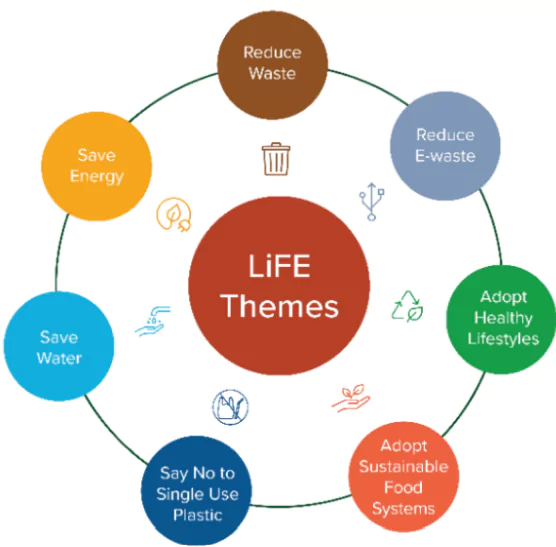 Green Deposits: The Central bank of India has implemented the Framework for Acceptance of Green Deposits for the Regulated Entities to foster and develop a green finance ecosystem in the country.
Green Deposits: The Central bank of India has implemented the Framework for Acceptance of Green Deposits for the Regulated Entities to foster and develop a green finance ecosystem in the country. -
- Call for Sustainable Lifestyles: India and Sweden head ‘The Leadership Group for Industry Transition’. With the ‘Lifestyle for Environment’ movement, India shows that convenient actions are the only way possible and that India’s sustainable lifestyles are the way forward.
- Green Credit Program: At COP28, India felt its presence by introducing the Green Credits Program, transcending the commercial nature of carbon credits.
- Participants can earn Green Credits for a wide range of activities that promote environmental sustainability.
- Committed Actions: India is also unprecedentedly focused on providing basic services such as pucca housing, round-the-clock electricity, clean drinking water, universal health insurance, and clean cooking gas.
- These are remarkable steps in the fight against climate change.
- Green Climate Fund (GCF): India’s involvement in the GCF, where it has pledged contributions and actively encourages G20 members and developed countries to increase their support.
- Nationally Determined Contributions (NDC): A climate action plan to cut emissions and adapt to climate impacts.
- In August 2022, India updated its NDC, according to which the target to reduce the emissions intensity of its GDP has been enhanced to 45% by 2030 from 2005 level, and the target on cumulative electric power installed capacity from non-fossil fuel-based energy resources has been enhanced to 50% by 2030.
- India’s Panchamrit:
- Reach 500 GW Non-fossil energy capacity by 2030
- 50% of its energy requirements from renewable energy by 2030
- Reduction of total projected carbon emissions by 1 billion tonnes from now to 2030
- Reduction of the carbon intensity of the economy by 45% by 2030, over 2005 levels
- Achieving the target of net zero emissions by 2070
- Common but Differentiated Responsibilities and Respective Capabilities (CBDR–RC): It is a principle within the United Nations Framework Convention on Climate Change (UNFCCC) that acknowledges the different capabilities and differing responsibilities of individual countries in addressing climate change.
- India has been a consistently strong voice of the Global South for the CBDR-RC principle was developed largely through Indian interventions at the Rio Summit, 1992.
- India leading International Initiatives Addressing Climate Change Issues: India is leading several international initiatives towards climate change mitigation and building resilience such as the International Solar Alliance (ISA), One World, One Sun, One Grid (OSOWOG), the Coalition for Disaster Resilient Infrastructure (CDRI), the Infrastructure for Resilient Island States’ (IRIS) and the Leadership Group for Industry Transition (LeadIT).
- India is a world leader in climate action today. It has added two more C’s to its climate policy: confidence and convenient action.
- India’s long-term low emissions development strategy to the UNFCCC showcases its belief in the multilateral process to achieve net zero by 2070.
- A Fundamental Right: Recently, the Supreme Court has expanded the scope of fundamental rights to include “the right to be free from adverse effects of climate change”.
Check Out UPSC CSE Books From PW Store
Challenges with Energy Transition
Despite various development, India has following challenges that need to be resolved:
- More Demand for Resources: Expanding renewable energy and clean fuels will increase demand for land and water. Most renewables are land-intensive and demand the highest land use requirements among the different energy sources.
- Dependency on Critical Minerals: The expansion of renewable energy requires battery storage technologies which in turn require the availability of critical minerals and the source of such minerals is geographically concentrated.
- Technological Limitations: It impacts the development and implementation of effective climate change policies.
- While renewable energy technologies have advanced rapidly in recent years, carbon capture and storage technologies that could help mitigate emissions from existing infrastructure are still in the early stages of development and face technical challenges.
- High Reliance on the Use of Coal: India is trying to meet its NDCs with clear long-term policies that promote renewable energy, but its heavy reliance on coal, along with oil and gas, is still meeting its growing energy needs.
- Coal is the most essential and abundant fossil fuel in India, accounting for 55% of the country’s energy needs.
- As per the International Energy Agency, in 2022, with an annual production of 310 million tonnes and imports of almost 25 million tonnes, coal will provide one-third of the energy supply in India.
- Climate Finance: Transitioning to a low-carbon economy requires substantial investments in renewable energy, energy efficiency, infrastructure, and sustainable land use practices.
- India needs substantial climate finance by 2050 to achieve its ambitious sustainability goals. An estimated US$10.1 trillion will be required to reach net zero by 2070 (World Bank).
- Difficulty in Prediction: Climate change is a multifaceted phenomenon, including greenhouse gas emissions, land use changes, industrial activities, and natural processes and their interconnectedness, which makes it difficult to predict the nature and impact of climate change.
- A Balancing Dilemma: Balancing economic development with environmental sustainability is a delicate task for policymakers, especially in India and countries heavily reliant on fossil fuels.
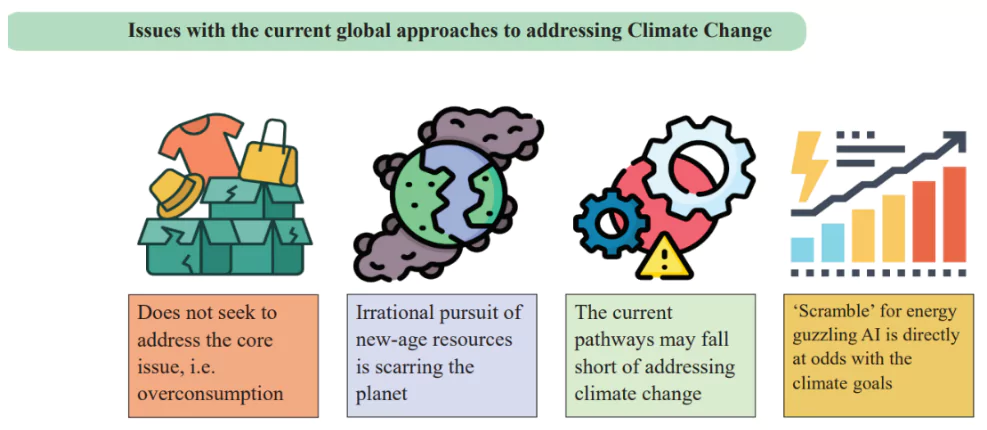 As per the World Bank, climate change could push more than 100 million people into extreme poverty by 2030 by disrupting agriculture and fueling the spread of malaria and other diseases.
As per the World Bank, climate change could push more than 100 million people into extreme poverty by 2030 by disrupting agriculture and fueling the spread of malaria and other diseases.
- Socio-economic Concern: Vulnerable populations, such as low-income communities, indigenous peoples, and small island nations, face the severe impact of climate change effects.
- Flaws with Global Strategies: Current global strategies for climate change are flawed and not universally applicable.
- The Western approach fails to address the root cause of the problem, which is overconsumption. Instead, it focuses on substituting means to achieve overconsumption.
Global Strategy on Clean Energy
World Energy Outlook (WEO)-2023 proposes a global strategy for getting the world on track by 2030. The Five Key Pillars to this proposal include:
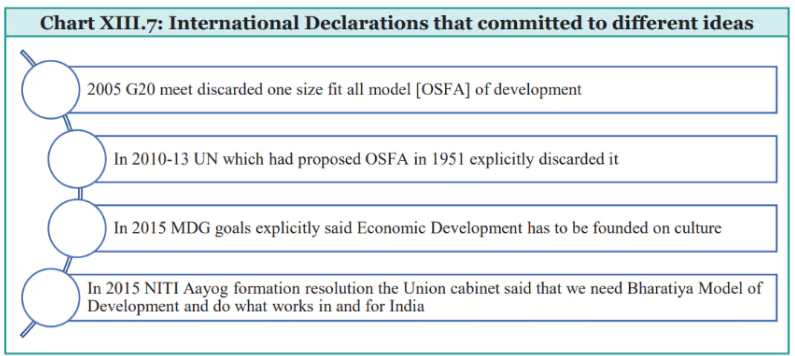
- Tripling global Renewable Energy Capacity
- Doubling the rate of Energy Efficiency Improvements
- Slashing methane emissions from fossil fuel operations by 75%
- Innovative, large-scale financing mechanisms to triple clean energy investments in emerging and developing economies
- Measures to ensure an orderly decline in the use of fossil fuels, including an end to new approvals of unabated coal-fired power plants
|
Way Forward
In order to mitigate climate change, there is a need for a balanced approach to energy transition, and the importance of sustainable development.
- Alternative Demands: India’s energy needs are expected to grow 2 to 2.5 times by 2047 to meet a growing economy’s developmental priorities and aspirations. Considering that resources are limited, the pace of energy transition would need to factor in alternative demands on the resources for improving resilience to climate change and for sustained social and economic development.
 Need for Tailored Approaches: The recent Economic Survey emphasizes that India must have its own method to combat climate change. It must not follow the Western approach, which doesn’t fall in line with the nation’s needs. India’s plan to mitigate climate change must take into account the country’s unique cultural and social fabric.
Need for Tailored Approaches: The recent Economic Survey emphasizes that India must have its own method to combat climate change. It must not follow the Western approach, which doesn’t fall in line with the nation’s needs. India’s plan to mitigate climate change must take into account the country’s unique cultural and social fabric.-
- India emphasises a harmonious relationship with nature such as Mission LiFE focuses on promoting human-nature harmony. It emphasises mindful consumption over overconsumption, which is central to addressing global climate change issues.
- Focus on Sustainable Housing: Shifting towards ‘traditional multi-generational households’ can create pathways to sustainable housing.

- Long-Term Targeted Policies: Financial, political, and policy leadership lies at the bottom of all the recommendations for climate change policy for India. Policies and actions should be taken while considering their long-term impacts.
- Policymakers must develop policies addressing socio-economic disparities and ensuring equitable outcomes.
- Encouraging Innovation: As per the World Economic Forum, the use of artificial intelligence (AI) can contribute to the fight against climate change. Existing AI systems include tools that predict weather, track icebergs and identify pollution. AI can also be used to improve agriculture and reduce its environmental impact.
- Example: The Data in Climate Resilient Agriculture (DiCRA) platform, launched by the United Nations Development Programme and the Telangana government, uses Artificial Intelligence to improve food systems and security.
- The platform provides farmers with crucial data and analytics to combat the impact of climate change on their crops and livestock, enhancing their resilience and securing their livelihoods.
- More Investment: While reducing emissions is critical, it is equally important that we invest in technologies and infrastructure to help communities adapt to the crisis already at hand.
- This is especially true for vulnerable communities in developing countries that are in dire need of investment in climate-resilient infrastructure, such as drought-resistant crops, flood protection systems, and early warning systems for extreme weather events.
- Other Measures: Coal, a major player in India’s energy sector, needs to be regulated, forests that are carbon sinks (help in Carbon sequestration) need sustainable management from cooperative efforts of local communities and government and need for a Collaborative Effort to meet the aspirations of a climate-resilient planet and achieve long-term sustainable growth.
Enroll now for UPSC Online Classes
Conclusion
India recognises that development and environment are two sides of the same coin and must be considered together for holistic development. To solve a global problem like climate change, the world needs to believe in the age-old Indian ethos of ‘Vasudhaiva Kutumbakam’—One Earth, One World, and One Future.
![]() 24 Jul 2024
24 Jul 2024
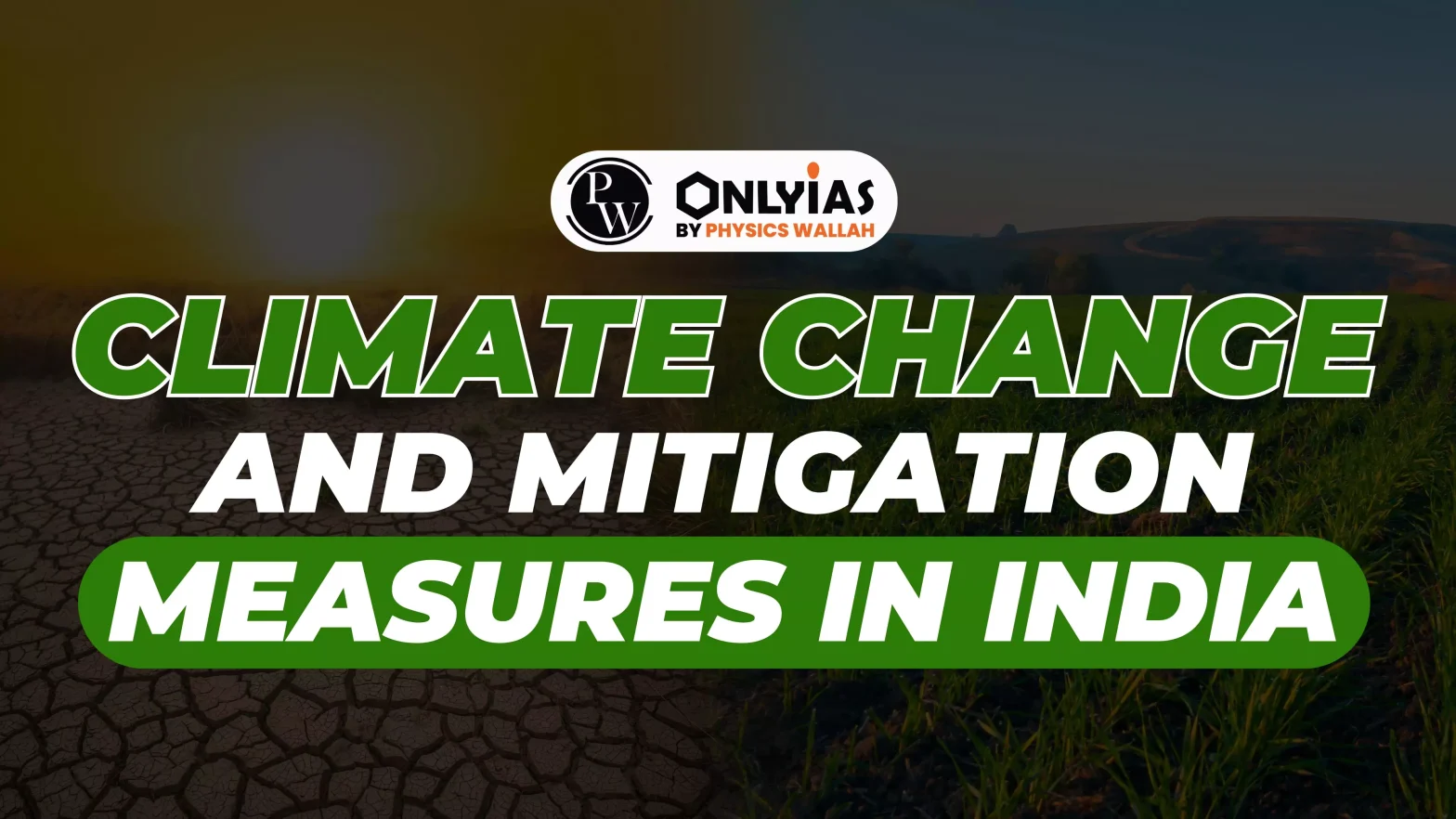



 Green Deposits: The Central bank of India has implemented the Framework for Acceptance of Green Deposits for the Regulated Entities to foster and develop a green finance ecosystem in the country.
Green Deposits: The Central bank of India has implemented the Framework for Acceptance of Green Deposits for the Regulated Entities to foster and develop a green finance ecosystem in the country.  As per the World Bank, climate change could push more than 100 million people into extreme poverty by 2030 by disrupting agriculture and fueling the spread of malaria and other diseases.
As per the World Bank, climate change could push more than 100 million people into extreme poverty by 2030 by disrupting agriculture and fueling the spread of malaria and other diseases.
 Need for Tailored Approaches: The recent Economic Survey emphasizes that India must have its own method to combat climate change. It must not follow the Western approach, which doesn’t fall in line with the nation’s needs. India’s plan to mitigate climate change must take into account the country’s unique cultural and social fabric.
Need for Tailored Approaches: The recent Economic Survey emphasizes that India must have its own method to combat climate change. It must not follow the Western approach, which doesn’t fall in line with the nation’s needs. India’s plan to mitigate climate change must take into account the country’s unique cultural and social fabric.
